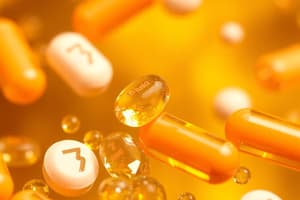Podcast
Questions and Answers
What is the primary focus of pharmacokinetics?
What is the primary focus of pharmacokinetics?
- The fate of a drug in the body after administration (correct)
- The side effects caused by drugs
- The synthesis of new pharmaceutical compounds
- The interaction of drugs with receptors
Which factor does NOT influence the bioavailability of orally administered drugs?
Which factor does NOT influence the bioavailability of orally administered drugs?
- Formulation of the drug by the manufacturer
- The age of the patient (correct)
- The site of drug administration
- Physical properties of the drug
What does a high bioavailability indicate about a drug administered intravenously?
What does a high bioavailability indicate about a drug administered intravenously?
- It has a quick elimination rate.
- It is poorly absorbed in the body.
- It reaches circulation effectively. (correct)
- It is only effective in certain formulations.
How do lipid-soluble drugs primarily behave in the body?
How do lipid-soluble drugs primarily behave in the body?
What happens to the absorption of a drug if it stays longer in the tissues?
What happens to the absorption of a drug if it stays longer in the tissues?
What effect do anticholinergics have on gastric emptying?
What effect do anticholinergics have on gastric emptying?
How does food presence affect the absorption of lansoprazole?
How does food presence affect the absorption of lansoprazole?
What can reduce the absorption of tetracyclines?
What can reduce the absorption of tetracyclines?
Which factor can inhibit drug absorption in the gastrointestinal tract?
Which factor can inhibit drug absorption in the gastrointestinal tract?
Which protein acts as a carrier for drugs in the bloodstream?
Which protein acts as a carrier for drugs in the bloodstream?
What is the primary organ responsible for drug excretion?
What is the primary organ responsible for drug excretion?
Which route is primarily responsible for excreting water-soluble drugs?
Which route is primarily responsible for excreting water-soluble drugs?
How is the clearance (Cl) of a drug expressed?
How is the clearance (Cl) of a drug expressed?
What range of GFR (mL/min) indicates mild renal impairment?
What range of GFR (mL/min) indicates mild renal impairment?
What is the primary purpose of Phase I metabolism?
What is the primary purpose of Phase I metabolism?
Which method is commonly used to estimate kidney function?
Which method is commonly used to estimate kidney function?
Which of the following metabolic processes are characteristic of Phase II metabolism?
Which of the following metabolic processes are characteristic of Phase II metabolism?
What is the result of first pass metabolism?
What is the result of first pass metabolism?
Which system catalyzes most phase I reactions of drug metabolism?
Which system catalyzes most phase I reactions of drug metabolism?
What happens to a drug during Phase II metabolism?
What happens to a drug during Phase II metabolism?
Which of the following is a common mechanism in Phase II drug metabolism?
Which of the following is a common mechanism in Phase II drug metabolism?
How can Phase I metabolism affect the pharmacological activity of a drug?
How can Phase I metabolism affect the pharmacological activity of a drug?
Which of the following organs are involved in Phase II metabolism?
Which of the following organs are involved in Phase II metabolism?
What primarily influences the rate of drug entry into tissues?
What primarily influences the rate of drug entry into tissues?
What does a high volume of distribution (Vd) typically indicate about a drug?
What does a high volume of distribution (Vd) typically indicate about a drug?
Where does the majority of drug metabolism occur in the body?
Where does the majority of drug metabolism occur in the body?
What is a prodrug?
What is a prodrug?
What happens to the metabolism of drugs as individuals age?
What happens to the metabolism of drugs as individuals age?
How do cytochrome P450 enzymes function concerning drug metabolism?
How do cytochrome P450 enzymes function concerning drug metabolism?
What is the relationship between protein binding and drug action?
What is the relationship between protein binding and drug action?
What can affect the activity of liver enzymes involved in drug metabolism?
What can affect the activity of liver enzymes involved in drug metabolism?
Flashcards are hidden until you start studying
Study Notes
Pharmacokinetics
- Focuses on the drug's fate in the body after administration, described through Absorption, Distribution, Metabolism, and Elimination (ADME).
Absorption
- Refers to the passage of a drug into systemic circulation after administration.
- Crucial for various administration routes, especially intravenous.
Bioavailability
- Represents the proportion of an administered drug that reaches systemic circulation.
- Intravenous administration has 100% bioavailability; oral bioavailability varies due to multiple factors.
Factors Affecting Oral Absorption
- Physical Properties: Lipophilic drugs cross cell membranes easily; e.g., Propofol penetrates the CNS, while water-soluble drugs like Amiodarone remain in blood vessels.
- Drug Formulation: Enteric-coated drugs release in the intestines; sustained-release formulations manage prolonged absorption.
- Gastric Emptying: Can speed up or delay drug absorption; e.g., anticholinergics can slow gastric emptying.
- Food Interaction: Food can enhance or reduce absorption; e.g., some drugs require an empty stomach, while others have reduced efficacy with food.
- Drug-Disease Interactions: Conditions like Atrial Fibrillation can affect drug bioavailability, as can the intake of certain foods.
Drug Distribution
- After absorption, drugs are distributed in plasma and various tissues, affected by blood flow.
- Drugs partly remain in solution, while some bind to plasma proteins (e.g., albumin).
- The free (unbound) state of drugs is crucial for pharmacologic action.
Volume of Distribution (Vd)
- Indicates the extent of drug distribution in the body, calculated based on plasma concentration.
- High Vd suggests wide distribution; low Vd indicates retention in plasma.
Metabolism
- Involves chemical modification of drugs, primarily occurring in the liver, with contributions from lungs, kidneys, and the gastrointestinal tract.
- Cytochrome P450 enzymes are key players in drug metabolism; they can convert drugs into active or inactive metabolites.
- Drug metabolism can differ with age; neonates and elderly have altered metabolizing capabilities.
Phase I Metabolism
- Involves modifying drug structure through oxidation or reduction, often leading to more polar, less pharmacologically active metabolites.
- Example: Diazepam is converted to desmethyldiazepam via Phase I reactions.
Phase II Metabolism
- Complements Phase I, where drugs conjugate with other molecules, making them more water-soluble and easier to excrete.
- Example: Glucuronidation renders drugs inactive and facilitates excretion.
First-Pass Metabolism
- Metabolism of drugs occurs in the liver after absorption from the gastrointestinal tract before entering systemic circulation.
- This effect can significantly reduce the active drug's presence in circulation.
Elimination
- The excretion of drugs and metabolites from the body, mainly via the liver, kidneys, and lungs.
- Drug excretion routes can also include saliva, sweat, breast milk, and hair, though these are less significant.
Clearance (Cl)
- Measures the body's ability to eliminate a drug, expressed as a volume per unit of time (e.g., mL/min).
- Glomerular filtration rate (GFR) estimates kidney function, with creatinine clearance being commonly used.
Classification of Renal Impairment
- Mild Impairment: GFR 60-90 mL/min
- Moderate Impairment: GFR 20-60 mL/min
- Severe Impairment: GFR <20 mL/min
Studying That Suits You
Use AI to generate personalized quizzes and flashcards to suit your learning preferences.





